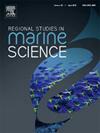Distributions and influencing factors of heavy metals in the coastal areas of the Yangtze River Estuary, China
IF 2.1
4区 环境科学与生态学
Q3 ECOLOGY
引用次数: 0
Abstract
The sediment of coastal wetlands is the primary source and sink of heavy metals. Many heavy metal pollutants enter the wetlands with runoff, and the physicochemical processes such as adsorption/desorption and sedimentation/resuspension occur under the interaction of runoff, tide, and wave. Through field investigation, this paper studied the spatial and temporal distribution of heavy metal concentrations of particulate, dissolved, and sediment in the Yangtze River estuary in January and May 2021 and discussed the influence of water physicochemical conditions such as temperature (TEMP), dissolved oxygen (DO), pH, redox potential (Eh), salinity (SAL), electrical conductivity (EC), and suspended particulate matter (SPM) on heavy metal concentration. The risks of heavy metals in sediment in the Yangtze estuary were comprehensively evaluated by the geo-accumulation index (Igeo) method, potential ecological risk assessment, and the Sediment Quality Guidelines (SQGs). The principal component analysis (PCA) was adopted to explain the sources of different heavy metals. It was found that the particulate Cr and Cu in water mainly originated from atmospheric deposition. The dissolved Zn in water was attributed to ship emissions. The Cu in sediment mainly originated from anthropogenic emissions, and the Cd in sediment was mainly from atmospheric deposition.
长江口沿海地区重金属分布及影响因素
滨海湿地沉积物是重金属的主要来源和汇。许多重金属污染物随径流进入湿地,在径流、潮汐、波浪的相互作用下发生吸附/解吸、沉降/再悬浮等理化过程。通过野外调查,研究了2021年1 - 5月长江口颗粒物、溶解氧和沉积物重金属浓度的时空分布,探讨了温度(TEMP)、溶解氧(DO)、pH、氧化还原电位(Eh)、盐度(SAL)、电导率(EC)和悬浮颗粒物(SPM)等水体理化条件对重金属浓度的影响。采用地质累积指数法(Igeo)、潜在生态风险评价法和沉积物质量指南(SQGs)对长江口沉积物中重金属的风险进行了综合评价。采用主成分分析(PCA)对不同重金属来源进行了解释。研究发现,水体中颗粒Cr和Cu主要来源于大气沉降。水中溶解的锌是由船舶排放的。沉积物中的Cu主要来源于人为排放,Cd主要来源于大气沉降。
本文章由计算机程序翻译,如有差异,请以英文原文为准。
求助全文
约1分钟内获得全文
求助全文
来源期刊

Regional Studies in Marine Science
Agricultural and Biological Sciences-Ecology, Evolution, Behavior and Systematics
CiteScore
3.90
自引率
4.80%
发文量
336
审稿时长
69 days
期刊介绍:
REGIONAL STUDIES IN MARINE SCIENCE will publish scientifically sound papers on regional aspects of maritime and marine resources in estuaries, coastal zones, continental shelf, the seas and oceans.
 求助内容:
求助内容: 应助结果提醒方式:
应助结果提醒方式:


